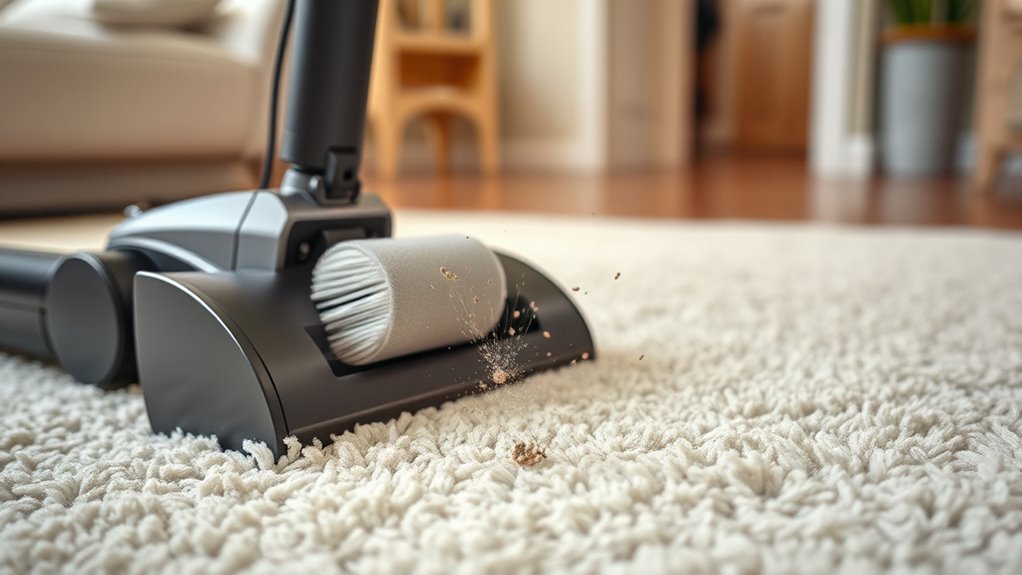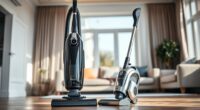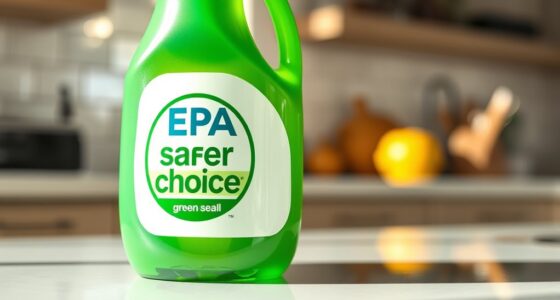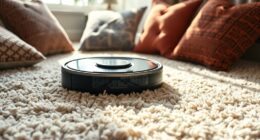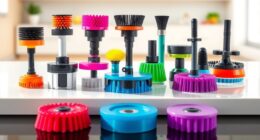To reduce dust mites effectively, choose a vacuum with a HEPA filter and a sealed system to trap allergens and prevent recirculation. Incorporate regular steam cleaning, especially on carpets and rugs, and use allergen-proof covers on bedding. Keep humidity below 50%, wash bedding weekly in hot water, and declutter your space to cut down dust buildup. Following these smart tips, you’ll find more ways to create a healthier, mite-free environment.
Key Takeaways
- Use vacuums with HEPA filters and sealed systems to trap allergens and prevent dust mite recirculation.
- Regularly steam clean carpets and rugs to kill dust mites and loosen debris.
- Maintain indoor humidity below 50% with dehumidifiers or air conditioners to inhibit mite growth.
- Wash bedding weekly in hot water and seal in allergen-proof covers for added protection.
- Incorporate air purifiers and declutter living spaces to reduce airborne allergens and dust accumulation.
Choosing the Right Vacuum for Dust Mite Control
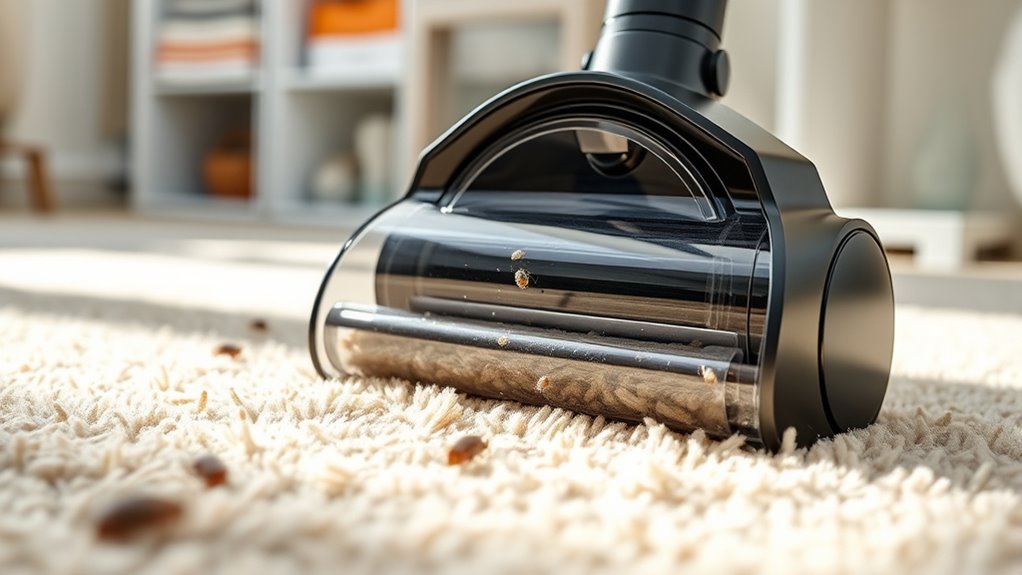
Choosing the right vacuum is vital for effectively reducing dust mites in your home. Look for models equipped with HEPA filters, which trap tiny particles and prevent them from recirculating into the air. HEPA filters are essential because dust mites and their allergens are often microscopic, so standard filters won’t do the job. Additionally, opt for vacuums with sealed systems, which guarantee that dust and allergens stay contained inside the unit rather than escaping back into your living space. Sealed systems improve overall air quality and make your cleaning more effective. Combining HEPA filters with sealed systems creates a powerful barrier against dust mite allergens, helping you maintain a cleaner, healthier environment. Make sure your vacuum is designed specifically for allergen control for the best results.
Innovative Floor Cleaning Techniques to Minimize Dust Mites
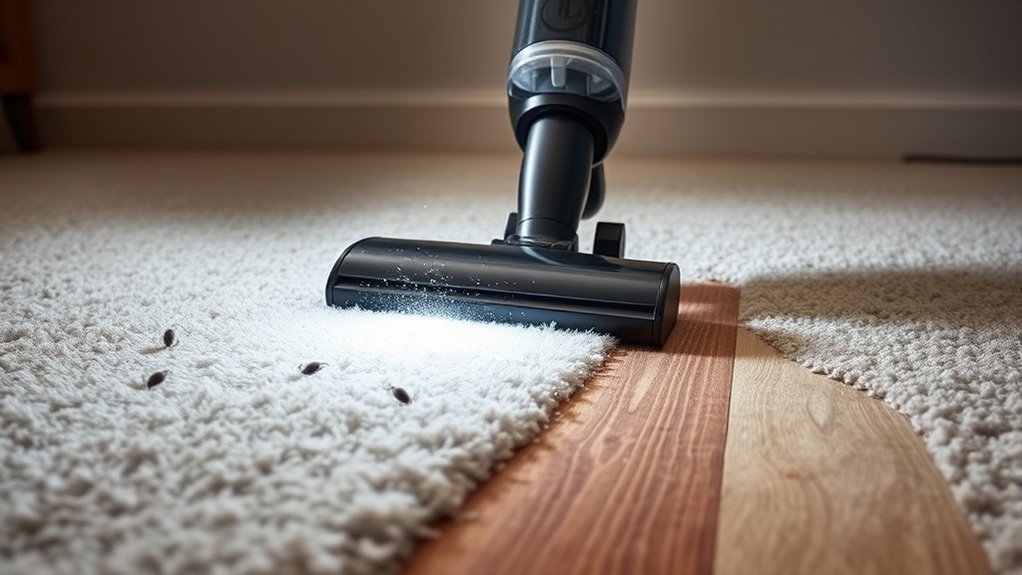
Once you’ve selected a vacuum with a HEPA filter and sealed system, maintaining a spotless floor becomes even more effective in reducing dust mites. To enhance this, try these innovative techniques:
- Use air purifiers in your rooms to continuously trap airborne dust and mite allergens, creating a cleaner environment.
- Regularly steam clean carpets and rugs, as high temperatures kill dust mites and loosen their debris.
- Incorporate hypoallergenic bedding and keep it sealed in allergen-proof covers to prevent mites from settling and spreading.
- Choose dog-friendly cleaning techniques and products that do not disturb your pet’s environment while effectively reducing allergens.
Combine these methods with frequent vacuuming and proper floor care to considerably cut down dust mite populations. These strategies work together to create a healthier, allergen-reduced space, especially when complemented by good airflow and bedding hygiene.
Smart Habits and Home Adjustments for Dust Mite Prevention
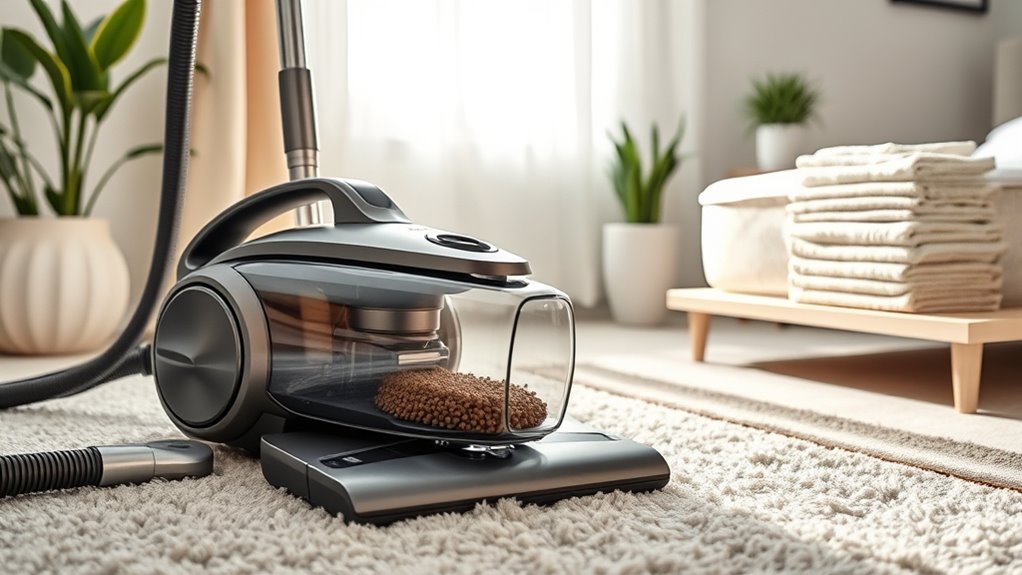
Implementing smart habits and making simple home adjustments can considerably reduce dust mite presence. Start by using an air purifier with a HEPA filter to trap airborne dust mites and allergens, improving your indoor air quality. Regular bedding maintenance is crucial—wash sheets, pillowcases, and blankets weekly in hot water to kill mites and remove dust buildup. Keep humidity levels below 50% with a dehumidifier or air conditioner, as dust mites thrive in humid environments. Declutter your home to eliminate dust traps and vacuum frequently, especially in bedrooms and carpets. Consider sealing mattresses and pillows in allergen-proof covers for added protection. Additionally, choosing Glycolic Acid products in appropriate concentrations can help improve skin barrier health, which may indirectly support allergy symptom management. These small changes can substantially cut down dust mite populations, helping you breathe easier and reducing allergy symptoms.
Frequently Asked Questions
Can Certain Vacuum Filters Trap All Dust Mite Allergens Effectively?
Yes, certain vacuum filters can trap dust mite allergens effectively. Look for vacuums with HEPA filtration, which are designed for allergen trapping. These filters capture tiny particles like dust mite waste and skin flakes, preventing them from recirculating into the air. Make sure the vacuum seals well and the HEPA filter is properly maintained or replaced regularly for maximum allergen removal. This way, you reduce allergy triggers more efficiently.
Are There Specific Floor Materials Less Prone to Dust Mite Accumulation?
Choosing the right floor can feel like picking a clear path through a maze. Hardwood and tile floors are less prone to dust mite buildup, unlike plush carpets and thick laminate, which trap allergens like a sponge. You’ll find hardwood and tile easier to clean and maintain, making them better options for allergy sufferers. Opt for these surfaces to reduce dust mite accumulation and breathe easier in your home.
How Often Should I Replace Vacuum Filters for Optimal Dust Mite Control?
You should replace your vacuum filters every 3 to 6 months to maintain ideal dust mite control. Regular vacuum maintenance extends the filter lifespan and ensures your vacuum is effectively capturing dust mites and allergens. If you notice a drop in suction power or increased dust escaping, it’s time to change the filter sooner. By staying on top of filter replacements, you improve air quality and reduce dust mite allergens in your home.
Do Air Purifiers Complement Vacuum Cleaning in Reducing Dust Mites?
Yes, air purifiers effectively complement vacuum cleaning by enhancing dust mite control. They improve air quality and target airborne allergens that vacuums might miss. When used together, the vacuum and purifier create a powerful synergy, reducing dust mites more effectively. For best results, choose an air purifier with a HEPA filter, ensuring maximum air purifier effectiveness, and regularly maintain both devices to keep your environment allergen-free.
Can Natural Cleaning Remedies Help Eliminate Dust Mites Better Than Chemical Cleaners?
Natural remedies can help reduce dust mites better than chemical cleaners because they often use ingredients like tea tree oil, eucalyptus, or baking soda, which have antimicrobial properties. You might find that natural remedies are gentler, safer, and less likely to trigger allergies. Chemical cleaners can sometimes leave residues or contain harsh chemicals that irritate sensitive skin or lungs, so switching to natural solutions could improve your indoor air quality and reduce dust mites more effectively.
Conclusion
Did you know that regular vacuuming with a HEPA filter can reduce dust mite allergens by up to 85%? By choosing the right vacuum, adopting innovative cleaning techniques, and making simple home adjustments, you can markedly lower dust mite levels. Stay consistent with these habits, and you’ll create a healthier living space. Don’t underestimate small changes—your home’s comfort and your health depend on it!
